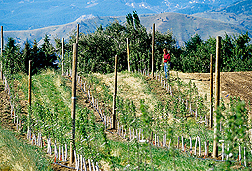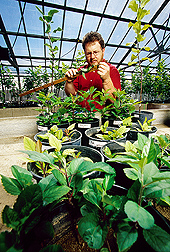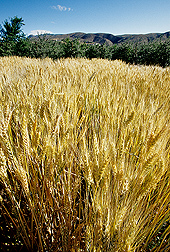Biocontrol Bacteria Hold Their Own—
to the Benefit of Apples
To hear Mark Mazzola describe his latest discovery in the weird, wild world of microorganisms, you’d think the amoebae he’s been studying—and the bacteria they stalk in the soil—were lion and wildebeest locked in an epic battle for survival on the plains of the Serengeti in East Africa.
Mazzola, a plant pathologist with the Agricultural Research Service in Wenatchee, Washington, is keen on understanding such microbial strife as part of a broader effort to devise new, integrated approaches to managing apple replant. It’s an apple tree disease that can cost Pacific Northwest growers as much as $40,000 per acre in diminished returns over 10 years, an orchard’s average productive life. Apple replant has been controlled with chemical fumigants, like methyl bromide, but using them is costly and environmentally worrisome.
Of particular interest to Mazzola is the role that resident populations of Pseudomonas bacteria could play in naturally protecting the trees’ roots from infection by the pathogens that together cause apple replant disease. Among them are Rhizoctonia fungi, Pythium oomycetes, and the parasitic nematode Pratylenchus penetrans.
|
|
Subterranean Slugfest
In studying how best to use Pseudomonas bacteria to control apple replant, Mazzola and colleagues made an interesting observation. When threatened by single-celled predators called “amoeba flagellates,” the rod-shaped bacteria band together and secrete surfactant-like proteins called “cyclic lipopeptides” (CLPs), forming a kind of biochemical picket line. Mazzola, who’s with ARS’s Tree Fruit Research Laboratory, gives the play-by-play:
“The amoebae follow their prey and then ingest it by forming cytoplasmic extensions”—otherwise known as “false feet”—which engulf and funnel the hapless captives into food vacuoles for digestion. But the Pseudomonas bacteria can sense the predators’ advance and respond by producing more CLPs as protectants.
The result for the amoebae is catastrophic. Upon contact with the CLPs, “the amoebae blow up, sometimes instantaneously,” says Mazzola, who’s captured the action on video. But without the CLPs to protect themselves, the bacteria become easy pickings for the amoebae.
The Haves and Have Nots
“We found that if you mutate the bacteria so that they can’t produce CLPs, their ability to survive predation declines significantly,” says Mazzola. He performed the research in collaboration with Jos M. Raaijmakers at Wageningen University, The Netherlands.
The team’s observations are drawn from petri dish, soil tube, and plant-root experiments in which two CLP-producing Pseudomonas fluorescens strains—SBW25 and SS101—and two nonproducing mutant strains—17A8 and 10.24—were exposed to the predatory amoeba Naegleria americana.
In the petri dish experiments, N. americana avoided areas inhabited either by SBW25 or SS101, but overran—and feasted on—the mutant strains. A similar fate befell the mutant bacteria in soil tests, while the CLP-producing strains persisted.
In related work, the team found that the CLP-gene-expression levels in strains SBW25 or SS101 increased by fourfold when the amoebae approached to within 1 centimeter of the bacteria.
“Collectively, these results show, for the first time, that CLPs produced by Pseudomonas contribute to their survival in soil and are potent defenses against amoeba predation,” Mazzola says.
The CLPs also serve other important functions, including enabling the Pseudomonas to move about and form protective biofilms—both of which may contribute to the bacteria’s usefulness as biological control agents against pathogens that cause apple replant disease.
Ousting Apple Replant from Orchards
In studies at Wenatchee since 2000, Mazzola and colleagues have sought to either replace or diminish the use of synthetic pesticides with a combination of strategies. One approach calls for planting wheat cover crops around newly planted apple trees. Nutrients leaking from the wheat’s roots can bolster populations of beneficial bacteria that help keep apple replant pathogens at bay.
Another strategy calls for treating the soils around trees with ground seed meal from canola and Brassica species, such as mustard. As they decompose, some seed meals increase bacteria that suppress Rhizoctonia fungi, while others release compounds called “isothiocyanates.” In both instances, the soil environment is changed such that it becomes hostile territory for Rhizoctonia fungi, diminishing their contribution to apple replant disease. Though the approach showed promise in field trials, use of canola seed meal unexpectedly increased populations of Pythium, necessitating use of the fungicide mefenoxam.
While mefenoxam use could fit in with an integrated approach to managing Pythium in conventionally grown orchards, it would not be a viable alternative for organic growers. Instead, they may be able to call on the soil’s contingent of CLP-producing Pseudomonas bacteria to dispatch Pythium.
Not all strains of Pseudomonas that suppress pathogens produce CLPs. But those that do, like SBW25 and SS101, stand a better chance of getting the job done in soils where predatory amoebae lurk.
Mazzola cautions against vilifying amoebae outright, though. Some species contribute to nitrogen recycling, which promotes soil health. Recognizing such nuances is at the heart of his team’s approach, which is to make the best of what nature already has to offer in place of chemical solutions synthesized in the factory.—By Jan Suszkiw, Agricultural Research Service Information Staff.
This research is part of Methyl Bromide Alternatives, an ARS national program (#308) described at www.nps.ars.usda.gov.
Mark Mazzola is with the USDA-ARS Tree Fruit Research Laboratory, 1104 N. Western Ave., Wenatchee, WA 98801-1230; (509) 664-2280, ext. 207.
"Biocontrol Bacteria Hold Their Own—to the Benefit of Apples" was published in the March 2010 issue of Agricultural Research magazine.









